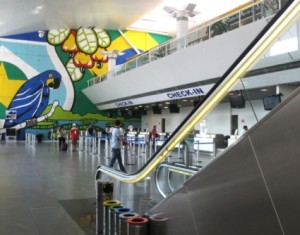
Photo © Michael Sommers.
In a blog piece I posted a few months ago, I waxed enthusiastic about the general joys of flying in Brazil and discussed the fact that due to a booming economy, and the trickle-down effect on consumers, more Brazilians are flying than ever before.
It turns out that nobody – including the Brazilian government whose corporation, INFRAERO, manages almost all (67) of Brazil’s airports – expected quite so many people to be flying around the Brazilian skies. As a result, despite significant renovations and expansions in recent years, it turns out that Brazil’s airports are still unprepared to deal with soaring passenger traffic. Although on weekdays and during off-season, things are still pretty fluid, long weekends and holiday periods are showing the strain with an increasing number of delayed and postponed flights at major hubs.
According to the IATA, 13 major airport terminals are already operating beyond their capacity.Things are especially critical when one considers that Brazil is set to be swamped by international travelers in 2014 (for the World Cup) and in 2016 (for the Summer Olympics). Indeed, at last month’s Latin American and Caribbean Air Transport Association conference, IATA chief executive officer Giovanni Bisignani minced no words when he declared that “Brazil is Latin America’s largest and fastest growing economy, but air transport infrastructure is a growing disaster. To avoid a national embarrassment, Brazil needs bigger and better facilities for the 2014 FIFA World Cup and the 2016 Olympics. But I don’t see progress and the clock is ticking.”
According to the IATA, 13 major airport terminals are already operating beyond their capacity. However, the most critically overtaxed of them all is São Paulo’s Guarulhos International Airport – a major domestic and international hub where the majority of overseas flights land before passengers can make a connection to other cities (including Rio).
Despite its concerns, IATA is still optimistic enough about Brazil’s potential to increase investments in the country. Its enthusiasm stems from the recent mega-merger between Brazil’s TAM and Chile’s LAN) (the ramifications of which were discussed in a post by my Moon.com colleague Wayne Bernhardson) coupled with the fact that the number of flights to and from Latin America is expected to increase significantly over the next few years, at rates higher than any other region in the world.
In the meantime, if you’re flying to – and especially around – Brazil, consider booking flights at times when traffic will be low (i.e. not at the beginning or end of a long holiday or weekend – of which there are many), and if you’re dealing with connections between flights or between other forms of travel (i.e. buses), factor in at least a little bit of time for possible delays.